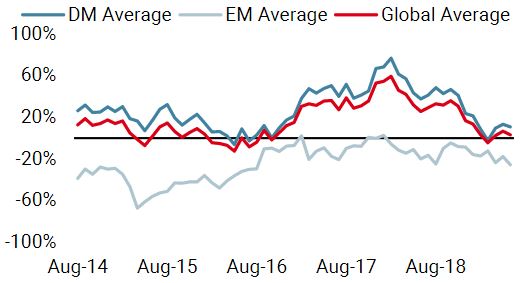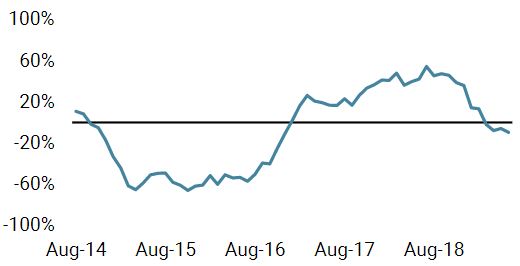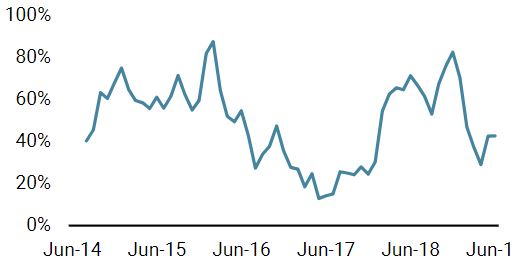This week’s Fed meeting will likely be one of the most important in recent years. For the first time since 2009, markets are expecting the Fed to cut rates four times in one year, with the first cut expected as early as September. What would warrant such an early cut when signs of an immediate recession are still limited? In our view, three elements would justify further Fed dovishness: first, US dollar strength has a monetary tightening effect, and shrinking the yield gap between the US and its trading partners should relieve this pressure. Second, the Fed could help smooth the impact of the White House’s trade war to the real economy. Finally, lower inflation pressures and expectations are freeing the Fed’s hands from the need to hike. We expect, at the very least, no further hikes forecasted by the Fed members in their “dots” for this year, but also volatility along the way given the extreme market pricing. A first cut in September would indeed have a deep effect on markets, bolstering equities and bonds over the medium term once more. Investors are pricing a severe sequence of cuts across the next two years, with two of them occurring by the end of this year. Such a pricing happened six months prior to the last recession, in July 2007. Are there currently signs of a recession in the US? According to our Growth Nowcaster, the US economy moved from expanding significantly above potential in early 2018 to hovering around it today. The pace of this deceleration has been strong and steep, leading us to seriously consider the likelihood of a recession. Currently our growth indicator in the US is pointing to growth stabilisation at best, making us worried about the potential end of the current cycle for solid reasons. The housing sector started showing a deterioration early this year while expectations (essentially ISM numbers) continuously dropped in the meantime to reach levels that are flirting with the danger zone. Yet, in spite of this deceleration, there is limited evidence that the US is in, or close to, a recession as employment remains solid while the housing market profited from the recent (and unexpected) drop in rates, which fell almost continuously over the past six months. There are pockets of weakness in the US macro situation (essentially durable goods consumption) but the macro dynamics described by the current data is marginally less worrisome for now, at least according to our systematic indicators. Indeed, the current levels are nowhere near where they were even two years before the GFC. If a recession is not yet on the cards, we see an interesting parallel with 1995: late that year, the Fed cut rates several times without the US being in a recession. At the time, emerging economies saw a severe economic slowdown, especially in Latin America. For example, Mexico went through a recession in 1995 that was around three times more severe than what it experienced in 2008. The Fed’s intention back then was to both limit US dollar upside against the other Latin American currencies while also smoothing the potential impact of the recession in the US’s major trading partners. How are emerging economies faring today? Much better in level terms than in 1995, especially Latin America (and Mexico in particular). According to our nowcasters, the weakest link in this emerging economic chain today is China.“THE FIRST CUT IS THE DEEPEST” – Cat Stevens, 1967
What’s Next?
Cutting rates without a recession
The 1995 comparison
With the impact of the government stimulus at the beginning of the year behind us, the economy is showing further signs of weakness. Given the current trade war being waged between the US and China, this is one of the most solid leads to understanding why the Fed would cut rates so soon.

Outside an expected recession, there are actually two reasons that could push the Fed to cut rates so soon. First, external risks: regarding the trade war between the US and China, the Fed could provide some relief from the price shock that will hit US consumers sooner rather than later. Exporters have not lowered their prices in spite of the tariffs, meaning that the tariffs’ bill will be paid by US consumers and companies, as highlighted in a previous note of ours. This will result in a negative demand shock that remains to be seen in the actual economic figures, dragging on growth over the next few quarters. By lowering its target rate, the Fed could help the US economy navigate this expected exogenous shock.Without inflation, the Fed is a risk manager
Second, the US is the only major developed economy to raise interest rates since 2008, as the Fed acted swiftly and with force at the beginning of the crisis. This resulted in a large rate spread between the US and other G10 economies, yielding a strong US dollar period over the past four years. This strength is a net negative to the US economy and is also a reflection of the quantitative tightening that is still happening: since the beginning of the year, the Fed’s balance sheet contracted by roughly USD 150 billion. A large portion of this is simply Treasury bonds on the Fed’s balance sheet maturing, and within the next six months an additional USD 155 billion of bonds will also mature, shrinking further the overall quantity of available USD. With supply reducing, it is no wonder the US dollar remains so strong. This is a risk to the US economy and the Fed could legitimate its cuts – without stating it this way – by simply being a good risk manager, alleviating a part of the upward pressure on the greenback.
Finally, weaker inflation figures and much lower expected inflation metrics in the US are also making it possible for the Fed to play this active and somewhat unusual risk manager role. With the 10‑year breakeven rate at 1.6%, down from 2.1% eight months ago, and core inflation at 2% and declining, the case for hiking rates is pretty thin.
In conclusion, despite the unlikeliness of an imminent recession, there are elements that could justify the Fed meeting investor expectations. What will be the consequence for markets? We expect the Fed this week to clearly state that rate hikes are over, in line with its recent communication. Under this scenario, in spite of the clear hand extended to markets, we still expect risk premia to remain volatile, before another leg of the “beta party” begins. If the Fed delivers more than that, there is a case for a straight beta rally and USD relief that could benefit emerging assets.

The First Cut is the Deepest

Our medium-term view is less defensive than previous months. We have neutralised our underweight in emerging assets because risk aversion has declined. Regarding the growth-oriented asset exposure, we are still complementing our equity position with options to protect the portfolio in the case of equity drawdowns. Over the month so far, the Multi Asset Risk Targeted Strategy is up 0.47% versus 0.26% for the MSCI AC World Index, while the Barclays Global Aggregate (USD hedged) is up 0.10%. Year-to-date, the Multi Asset Risk Targeted Strategy has returned 5.39% versus 13.4% for the MSCI AC World index and 5.2% for the Barclays Global Aggregate (USD hedged). * The Multi Asset Risk Targeted Strategy performance is shown in USD net of fees for the representative account of the Multi Asset Risk Targeted (Medium) USD Composite and reflects the deduction of advisory fees and brokerage commission and the reinvestment of all dividends and earnings. Past performance is not indicative of future performance. This information is presented as supplemental information only and complements the GIPS compliant presentation provided on the following page.Strategy Behaviour
Performance Review
Unigestion Nowcasting
World Growth Nowcaster

World Inflation Nowcaster

Market Stress Nowcaster

Weekly Change
- Our world Growth Nowcaster increased again last week, with economic data showing stronger readings in the US and Canada.
- Our world Inflation Nowcaster declined last week in the countries where growth improved, mainly the US and Canada.
- Market stress declined over the past week following the equity rally.
Sources: Unigestion. Bloomberg, as of 17 June 2019.
Important Information Past performance is no guide to the future, the value of investments can fall as well as rise, there is no guarantee that your initial investment will be returned. This document has been prepared for your information only and must not be distributed, published, reproduced or disclosed by recipients to any other person. This is a promotional statement of our investment philosophy and services only in relation to the subject matter of this presentation. It constitutes neither investment advice nor recommendation. This document represents no offer, solicitation or suggestion of suitability to subscribe in the investment vehicles it refers to. Please contact your professional adviser/consultant before making an investment decision. Where possible we aim to disclose the material risks pertinent to this document, and as such these should be noted on the individual document pages. Please contact Unigestion for a complete list of all the applicable risks. Some of the investment strategies described or alluded to herein may be construed as high risk and not readily realisable investments, which may experience substantial and sudden losses including total loss of investment. These are not suitable for all types of investors. To the extent that this report contains statements about the future, such statements are forward-looking and subject to a number of risks and uncertainties, including, but not limited to, the impact of competitive products, market acceptance risks and other risks. As such, forward looking statements should not be relied upon for future returns. Data and graphical information herein are for information only and may have been derived from third party sources. Unigestion takes reasonable steps to verify, but does not guarantee, the accuracy and completeness of this information. As a result, no representation or warranty, expressed or implied, is or will be made by Unigestion in this respect and no responsibility or liability is or will be accepted. All information provided here is subject to change without notice. It should only be considered current as of the date of publication without regard to the date on which you may access the information. Rates of exchange may cause the value of investments to go up or down. An investment with Unigestion, like all investments, contains risks, including total loss for the investor. This information is issued by Unigestion (UK) Ltd (“Unigestion”), which is authorised and regulated by the UK Financial Conduct Authority (“FCA”). Unigestion is also registered as an investment adviser with the U.S. Securities and Exchange Commission (“SEC”). This information is intended only for professional clients, institutional clients and eligible counterparties, as defined by the FCA, and qualified purchasers as defined by the SEC and has therefore not been adapted to retail clients. Unigestion Multi Asset Risk-Targeted (USD): 31 December 2014 to 31 December 2018 1: This year is incomplete. Special Disclosure: For presentations prior to 31.03.2018 the strategy was measured against the LIBOR 3M USD + 4%. Beginning April 2018 the firm determined that the benchmark did not accurately reflect the strategy mandate and the benchmark was removed. Definition of the Firm: For the purposes of applying the GIPS Standards, the firm is defined as Unigestion. Unigestion is responsible for managing assets on the behalf of institutional investors. Unigestion invests in several strategies for institutional clients: Equities, Hedge Funds, Private Assets and the solutions designed for the clients of our Cross Asset Solution department. The GIPS firm definition excludes the Fixed Income Strategy Funds, which started in January 2001 and closed in April 2008, and the accounts managed for private clients. Unigestion defines the private clients as High Net Worth Families and Individual investors. Policies: Unigestion policies for valuing portfolios, calculating performance, and preparing compliant presentations are available upon request. Composite Description: The Multi Risk Targeted (Medium) composite was defined on 15 December 2014. It consists of accounts which aim to deliver consistent smooth returns of cash + 5% gross of fees across all market conditions over a 3-year rolling period. It seeks to achieve this by capturing the upside during bull markets while protecting capital during market downturns. Benchmark: Because the composites strategy is absolute return and investments are permitted in all asset classes, no benchmark can reflect this strategy accurately. Fees: Returns are presented gross of management fees, administrative fees but net of all trading costs and withholding taxes. The maximum management fee schedule is 1.2% per annum. Net returns are net of model fees and are derived by deducting the highest applicable fee rate in effect for the respective time period from the gross returns each month. List of Composites: A list of all composite descriptions is available upon request. Minimum Account Size: The minimum account size for this composite is 5’000’000.- USD. Valuation: Valuations are computed in US dollars (USD). Performance results are reported in US dollars (USD). Internal Dispersion & 3YR Standard Deviation: The annual composite dispersion presented is an asset-weighted standard deviation calculated for the accounts in the composite the entire year. When internal dispersion is not presented it is as a result of an insufficient number of portfolios in the composite for the entire year. When the 3 Year Standard Deviation is not presented it is as a result of an insufficient period of time. Compliance Statement Unigestion claims compliance with the Global Investment Performance Standards(GIPS®) and has prepared and presented this report in compliance with the GIPS standards. Unigestion has been independently verified for the periods 1 January 2003 to 31 December 2016. The verification report(s) is/are available upon request. Verification assesses whether (1) the firm has complied with all the composite construction requirements of the GIPS standards on a firm-wide basis and(2) the firms policies and procedures are designed to calculate and present performance in compliance with the GIPS standards. Verification does not ensure the accuracy of any specific composite presentation.
Year
Composite
Return Gross
of FeesComposite Net Return
Benchmark Return
Number of Accounts
Internal Dispersion
Composite 3-Yr Std Dev
Benchmark 3-Yr Std Dev
Composite AUM (M)
Firm
AUM (M)
2015
-1.61%
-2.80%
–
1
–
–
–
127.24
15,550.31
2016
5.05%
3.79%
–
1
–
–
–
129.66
18,144.46
2017
11.16%
9.82%
–
1
–
–
–
169.51
22,340.80
2018
-2.91%
-4.08%
–
1
–
–
–
286.93
21,403.49
20191
5.06%
4.74%
–
1
–
–
–
278.23
23,204.71
